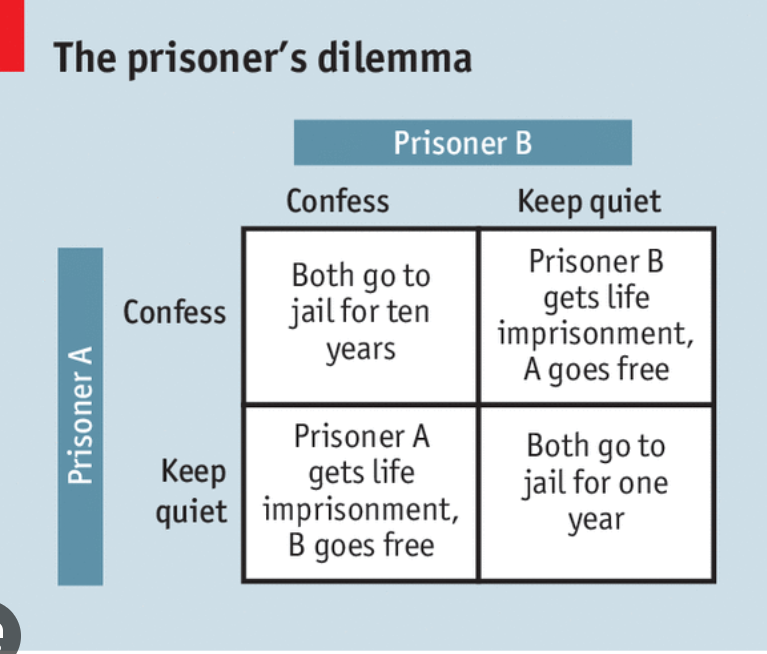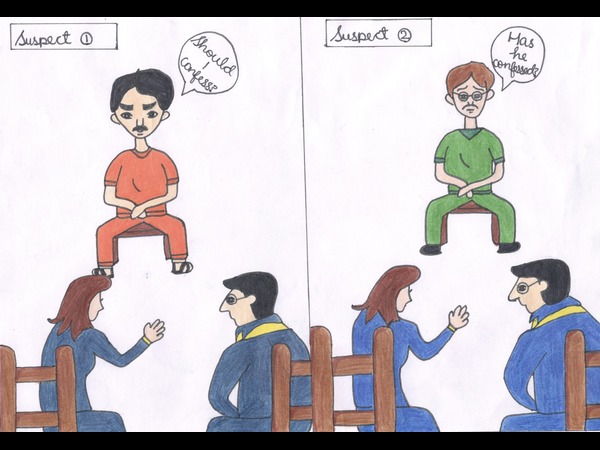Two suspects are arrested for a crime, and they are isolated from each other so they cannot communicate. The police have evidence to convict them of a lesser charge, but they lack strong evidence for a more serious charge, unless the convicts confess. The police offer each suspect the following options.
1. Keep quiet (Cooperate): If both suspects remain quiet (cooperate), there is not enough evidence to convict them of the serious charge, and they each receive 1 year in prison.
2. Confess (Betray): If one suspect remains quiet (cooperates) while the other confesses (betrays), the one who confesses will go free, while the one who remains quiet will face life imprisonment.
3. Mutual betrayal (Confess): If both suspects confess (betray), they both receive 10 years in prison.

Maximum Utility
“Maximum utility” refers to the outcome that maximizes the benefits or gains for an individual, given the choices they make in the context of the choices made by others. Each player’s goal is to achieve the best possible outcome for themselves, measured in terms of utility, satisfaction, or rewards.
From a perspective of “maximum utility,” each player’s best option seems to be betraying, as it offers the potential for the highest individual payoff (10 years worst case vs Life imprisonment worst case). However, the dilemma arises from the fact that if both players pursue their individual maximum utility (by betraying), they collectively end up in a worse situation compared to if they had both cooperated.
This demonstrates the tension between individual rationality and collective rationality. While both players can maximize their own utility by betraying, the overall outcome is suboptimal for both when compared to cooperation.
How does this apply to the real world?
The prisoner’s dilemma can be applied to various real-world situations. Take nuclear weaponry for example. Imagine two countries, Country A and Country B, each possessing nuclear weapons. They face the choice of either disarmament (Cooperate) or expanding their nuclear arsenals (Betray).
If both countries cooperate by disarming, global security and stability are improved. The risk of nuclear conflict is reduced, and resources saved can be redirected towards other priorities.
If one country cooperates by disarming while the other betrays by maintaining or expanding its nuclear capabilities, the betraying country gains a strategic advantage, potentially leading to coercive power in negotiations and conflicts.
If both countries betray and continue to build their nuclear arsenals, the global security situation worsens as the arms race intensifies, increasing the chances of accidental conflict or a destructive arms race.
From the perspective of maximum utility, each country’s primary goal is to ensure its own security and strategic advantage. If one country believes that the other will disarm, it might be tempted to betray and maintain its nuclear capabilities to gain a relative advantage. However, if both countries reason this way and both choose to betray, it leads to an escalation of nuclear arms and worsens global security.
In essence, the Prisoner’s Dilemma is a universal framework revealing the conflict between personal gain and collective prosperity. Across disciplines, it illustrates the balance between immediate rewards and lasting advantages, offering guidance in scenarios demanding cooperation and strategic foresight.
Shivi Vikram – AS Level, CS International.
Cover Illustration – Harsidha A – Grade 9, CS Academy.


